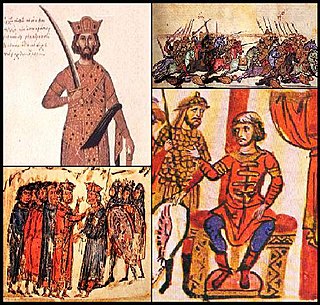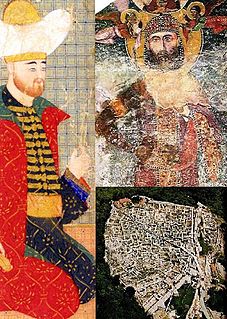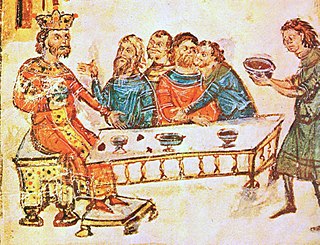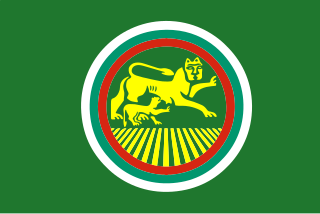
The Battle of Adrianople occurred around Adrianople on April 14, 1205 between Bulgarians and Cumans under Tsar Kaloyan of Bulgaria, and Crusaders under Baldwin I, who only months before had been crowned Emperor of Constantinople, allied with Venetians under Doge Enrico Dandolo. It was won by the Bulgarians, after a successful ambush.

The Battle of Legnica, also known as the Battle of Liegnitz or Battle of Wahlstatt, was a battle between the Mongol Empire and the combined defending forces of European fighters that took place at Legnickie Pole (Wahlstatt) near the city of Legnica in the Duchy of Silesia on 9 April 1241.
Beroe or Beroë may refer to :

{{Infobox War Faction |name= Byzantine army of the Komnenian period |war= the Byzantine-Seljuk wars, the Byzantine-Bulgarian Wars, the Byzantine-Norman Wars, the Crusades and other conflicts |image= |caption= Emperor John II Komnenos, the most successful commander of the Komnenian army. |active= 1081–1204 AD |leaders= Byzantine Emperor |headquarters=Constantinople |area= Anatolia, Southern Italy, Balkans, Hungary, Galicia, Crimea, [[Syria {region)|Syria]], Egypt. |strength=50,000 (1143-1180) |partof= Byzantine Empire |previous= |next= Nicaean/Palaiologan army |allies= Venice, Genoa, Danishmends, Georgia, Galicia, Vladimir-Suzdal, Kiev, Ancona, Hungary, Jerusalem, Tripoli, Antioch, Mosul. |opponents= Venice, Hungary, Danishmends, Bulgaria, Seljuks, Antioch, Sicily, Armenian Cilicia, Fatimids, Ayyubids, Pechenegs, Cumans. |battles= Dyrrhachium, Levounion, Nicaea Philomelion, Beroia, Haram, Shaizar, Sirmium, Myriokephalon, Hyelion and Leimocheir, Constantinople (1203), Constantinople (1204) }}

The Battle of Beroia was fought in 1122 between the Pechenegs and the Byzantine Empire under Emperor John II Komnenos in what is now Bulgaria. The Byzantine army won the battle, resulting in the disappearance of the Pechenegs as a distinct, independent people.
The Bulgarian–Latin wars were a series of conflicts between the Second Bulgarian Empire (1185–1396) and the Latin Empire (1204–61). The wars affected the northern border of the Latin Empire throughout its existence.

The Byzantine–Bulgarian wars were a series of conflicts fought between the Byzantines and Bulgarians which began when the Bulgars first settled in the Balkan peninsula in the 5th century, and intensified with the expansion of the Bulgarian Empire to the southwest after 680 AD. The Byzantines and Bulgarians continued to clash over the next century with variable success, until the Bulgarians, led by Krum, inflicted a series of crushing defeats on the Byzantines. After Krum died in 814, his son Omurtag negotiated a thirty-year peace treaty. In 893, during the next major war, Simeon I, the Bulgarian emperor, defeated the Byzantines while attempting to form a large Eastern European Empire, but his efforts failed.

The September Uprising was an armed insurgency staged in September 1923 by the Bulgarian Communist Party (BCP) under Comintern pressure, as an attempt to overthrow Alexander Tsankov's new government of Bulgaria that had come to power with the coup d'état of 9 June. Besides its communist base, the uprising was also supported by agrarians and anarchists. The uprising's goal was the "establishment of a government of workers and peasants" in Bulgaria, not the conversion of the country's socioeconomic system to communism.

The Bulgarian Land Forces are the ground warfare branch of the Bulgarian Armed Forces. The Land Forces were established in 1878, when they were composed of anti-Ottoman militia (opalchentsi) and were the only branch of the Bulgarian military. The Land Forces are administered by the Ministry of Defence, previously known as the Ministry of War during the Kingdom of Bulgaria.

The Bulgarian–Ottoman wars were fought between the kingdoms remaining from the disintegrating Second Bulgarian Empire, and the Ottoman Empire, in the second half of the 14th century. The wars resulted with the collapse and subordination of the Bulgarian Empire, and effectively came to an end with the Ottoman conquest of Tarnovo in July 1393, although other Bulgarian territories, such as the Tsardom of Vidin, held out slightly longer. As a result of the wars the Ottoman Empire greatly expanded its territory on the Balkan peninsula, stretching from Danube to the Aegean Sea.
The Battle of Ihtiman occurred in 1355 between Bulgarians and Ottomans and resulted in an Ottoman victory. The exact location is not known, but in an anonymous Bulgarian chronicle, it is mentioned that the armies of Michail Asen engaged the invading forces before they could reach Sofia.

The Battle of Antioch on the Meander was a military engagement near Antioch-on-the-Meander between the forces of the Empire of Nicaea and the Seljuk Sultanate of Rûm. The Turkish defeat ensured continued Nicaean hegemony of the Aegean coast of Asia Minor. The Seljuk sultan, Kaykhusraw I, was killed on the field of battle. The battle took place near the modern town of Yamalak in Kuyucak district in Aydın Province.

The Battle of Tryavna occurred in 1190, in the mountains around the contemporary town of Tryavna, central Bulgaria. The result was a Bulgarian victory over the Byzantine Empire, which secured the successes achieved since the beginning of the Rebellion of Asen and Peter in 1185.

The Battle of Philippopolis or Battle of Plovdiv took place on 30 June 1208 in the surroundings of Philippopolis between the armies of the Bulgarian Empire and the Latin Empire. The Crusaders were victorious.
The military history of the Crusader states begins with the formation of the County of Edessa in 1097 and ends with the loss of Ruad in 1302, the last Christian stronghold in the Holy Land.

The medieval Bulgarian army was the primary military body of the First and the Second Bulgarian Empires. During the first decades after the foundation of the country, the army consisted of a Bulgar cavalry and a Slavic infantry. The core of the Bulgarian army was the heavy cavalry, which consisted of 12,000–30,000 heavily armed riders. At its height in the 9th and 10th centuries, it was one of the most formidable military forces in Europe and was feared by its enemies. There are several documented cases of Byzantine commanders abandoning an invasion because of a reluctance to confront the Bulgarian army on its home territory.

Kran is a town in central Bulgaria. It is located just south of the Balkan Mountains and is administratively part of Kazanlak Municipality, Stara Zagora Province. Kran was an important castle of the Second Bulgarian Empire in the 13th–14th century. Among the local sights are a conserved ancient Thracian tomb, a much older Thracian sanctuary and the ruins of the medieval fortress.

The Nicaean–Latin wars were a series of wars between the Latin Empire and the Empire of Nicaea, starting with the dissolution of the Byzantine Empire by the Fourth Crusade in 1204. The Latin Empire was aided by other Crusader states established on Byzantine territory after the Fourth Crusade, as well as the Republic of Venice, while the Empire of Nicaea was assisted occasionally by the Second Bulgarian Empire, and sought the aid of Venice's rival, the Republic of Genoa. The conflict also involved the Greek state of Epirus, which also claimed the Byzantine inheritance and opposed Nicaean hegemony. The Nicaean reconquest of Constantinople in 1261 AD and the restoration of the Byzantine Empire under the Palaiologos dynasty did not end the conflict, as the Byzantines launched on and off efforts to reconquer southern Greece and the Aegean islands until the 15th century, while the Latin powers, led by the Angevin Kingdom of Naples, tried to restore the Latin Empire and launched attacks on the Byzantine Empire.





















